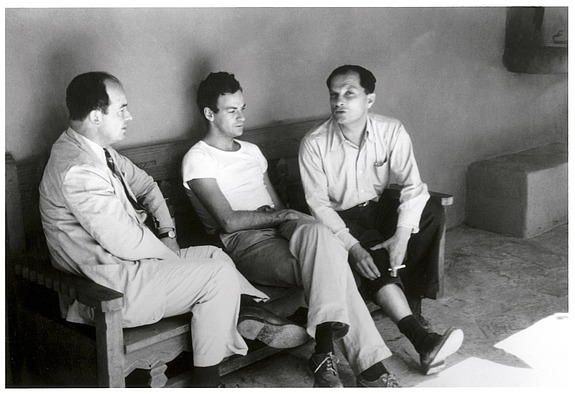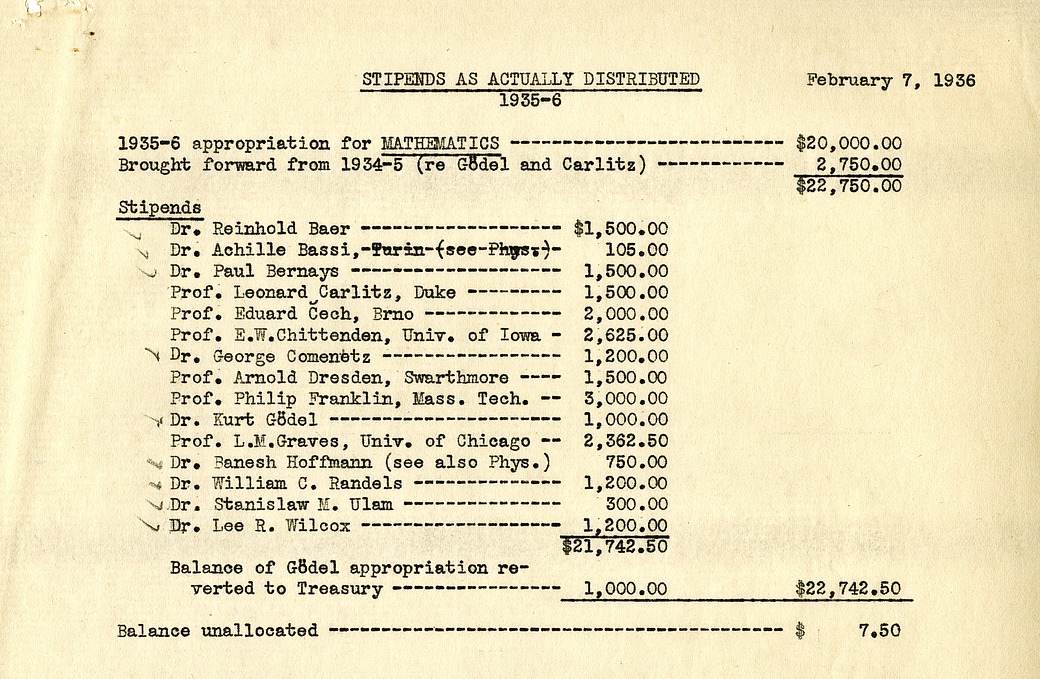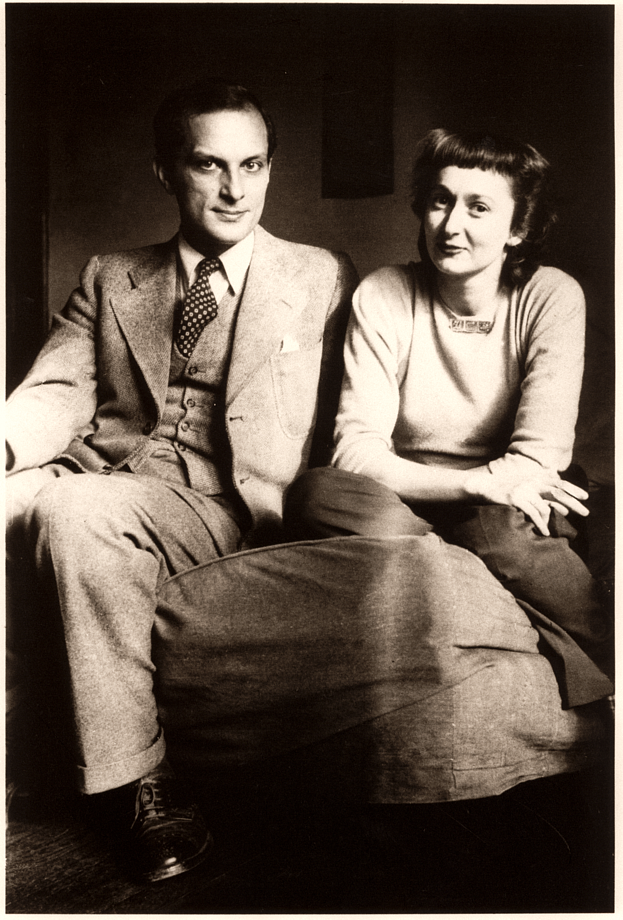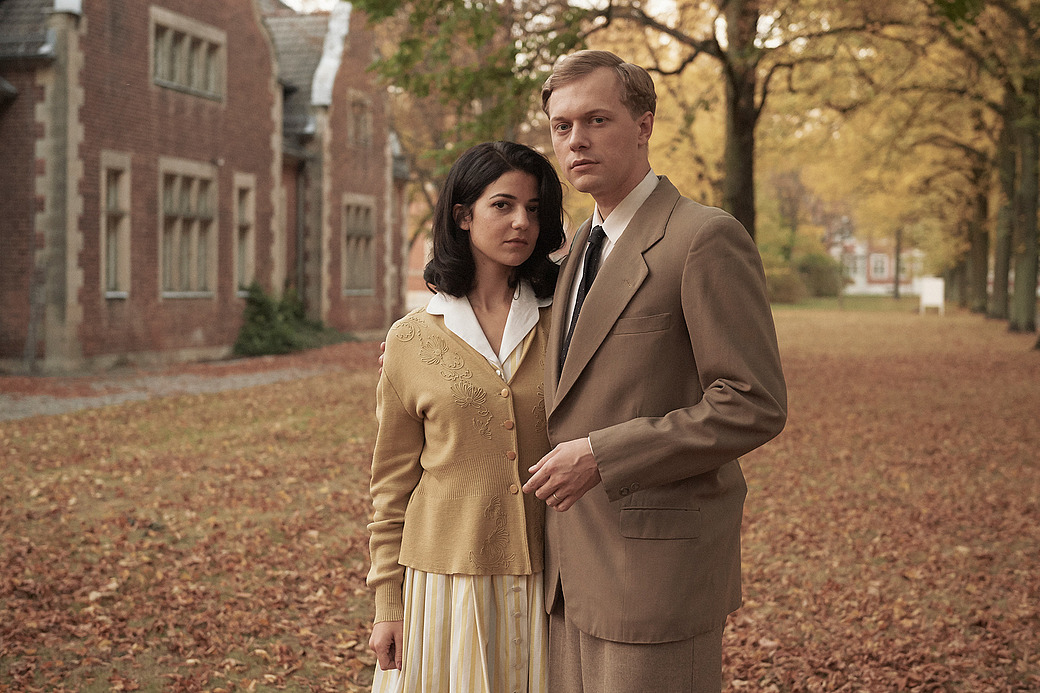Adventures of a Mathematician

The Institute for Advanced Study distributed $21,742.50 in stipends for mathematics and $10,000 for theoretical physics during the academic year 1935–36. Three hundred dollars, sufficient to secure entry to the United States, was awarded to the Polish mathematician Stanislaw Ulam (1909–84), who had written to John von Neumann about a problem in measure theory in 1934. Von Neumann followed up by arranging to meet at the train station in Warsaw while returning from a conference of topologists in Moscow in 1935. The Institute’s formal invitation followed, with Ulam sailing for New York aboard the Aquitania in December 1935. He and von Neumann remained intellectually inseparable until von Neumann’s death.
Françoise Ulam (née Fanchon Aron, 1918–2011) was born in a cellar during the bombardment of Paris at the end of World War I. Her family, who were “left-wing intelligentsia on one side and upper-crust Bohemianism on the other,” moved to Morocco in 1927, leaving her for two years on Place Saint-Michel in Paris with a childless aunt and uncle who were ardent communists, managers of a publishing house, and hosts of a celebrated literary salon. She learned English from a copy of Alice in Wonderland given to her by a British exchange student her hosts had taken in. In her own memoir, From Paris to Los Alamos, she plays the part of Alice, encountering many of the leading figures in twentieth-century mathematics and physics along the way.
Françoise applied to the Institute for International Education as an exchange student to the USA, and, in August of 1938, sailed for New York, making her way from there to Mills College in California by Greyhound bus. When her year at Mills was up, her mother warned her not to return to France, so she obtained a graduate scholarship to Mount Holyoke college in Massachusetts. There, at a party in Cambridge in the fall of 1939, she met Stan, who had secured a three-year fellowship under George David Birkhoff at Harvard, bringing his younger brother Adam (then seventeen) with him when he left Poland for the last time in August of 1939. They were on board the Batory, sailing for New York, when word came over the ship’s radio of the Molotov-Ribbentrop Pact. “This is the end of Poland,” Stan announced.

Stan and Françoise would both lose most of their families to the holocaust they had escaped. Stan and Adam, now too impoverished to afford restaurants, had been too wealthy in Poland to have learned to cook for themselves, so Françoise began cooking for the two brothers and joining them for meals. “These were the darkest days of the war,” she remembers. “For a five-cent cup of coffee Stan sat for hours in the Georgian cafeteria with Polish and other foreign mathematicians who had found their way to Cambridge, discussing the anxious war news or talking mathematics. They became my friends too and I would join them after work.”
Harvard was flooded with refugees and, in 1941, the renewal of Stan’s fellowship was turned down. He was rescued by the offer of an instructorship at the University of Wisconsin for $2,300 a year. Françoise followed him to Madison, bringing a degree from Holyoke and a five-dollar dress which she wore to their marriage before a justice of the peace. “Do you want the long or the short ceremony?” asked the judge, adding that the fee was two dollars for the short and five dollars for the long. “We’ll take the short,” answered Stan.
“Neither of us knew beans about domesticity,” said Françoise. Among friendly, no-nonsense American Midwesterners, they settled down as far as was possible amidst the reports filtering out from the communities in Europe that were being destroyed. Stan took flying lessons in hopes of joining the U.S. Air Force but, due to poor eyesight, his service was declined. On hearing the news in the spring of 1941 that “20 torpedo boats [would] go to England,” he wrote to von Neumann: “I could not help thinking that 50 bicycles would also be valuable.” Von Neumann replied that there was “interesting” war work going on but that “he could not tell [Stan] where.” Finally, in late 1943, these hints resulted in a cryptic invitation from Hans Bethe, which the Ulams accepted without knowing what they had agreed to, or where.
Thus, Stan and Françoise, with a baby on the way, found themselves at Los Alamos, where, as Stan put it, “the air felt like champagne.” The isolated community on the remote New Mexico mesa had become an intellectual utopia, a temporary parallel to the community of scholars that Abraham Flexner had assembled at the IAS. “In the entire history of science there had never been anything even remotely approaching such a concentration,” Stan commented, noting, “At thirty-four I was already one of the older people.” The barriers between disciplines and backgrounds evaporated. For the first time since leaving Lwów and Paris, Stan and Françoise felt at home. This feeling was widely shared. “Los Alamos became a great baby farm,” says Françoise, “which annoyed General Groves.”
With on-site child care, health care, and school, it was easy—and expected—for the women at Los Alamos, many of whom were themselves scientists, to work. Françoise first joined the Documents Division, applying her training and family background in journalism to helping Emily Morrison and David Hawkins compile the definitive official history of Los Alamos (Manhattan District History: Project Y, the Los Alamos Project, released in two declassified volumes, totaling 612 pages, in 1961). She then joined the Theoretical Division as a data analyst, where she was happy to be working in proximity to Stan, but uncomfortable to be working on bombs.

Stan had a special gift (perhaps derived from his Polish sense of humor) of quietly following a mathematical or scientific concept for a while and then suddenly giving it an unexpected flip, the way a joke is revealed at the very end. Four of the twentieth-century’s great innovations—the Monte Carlo method for statistical analysis of otherwise intractable processes, the “Teller-Ulam Invention” of radiation implosion that enabled the hydrogen bomb, the idea of nuclear pulse propulsion of space vehicles that enabled Project Orion, and the idea of universal cellular automata—originated, seemingly effortlessly, with Stan. He invented Monte Carlo while playing endless games of solitaire after being told to stop thinking while recovering from viral encephalitis; he envisioned Project Orion, wondering why we don’t use bombs to deliver rockets instead of using rockets to deliver bombs; his ideas about cellular automata crystallized after a conversation with von Neumann on a park bench in Central Park, which had been convened to pass along the top-secret news that his thermonuclear invention had just yielded 10.2 megatons in its first test, the underlying breakthrough having been achieved by accident while trying to prove that Edward Teller’s approach was a dead end. “I found him at home at noon staring intensely out of a window with a very strange expression on his face,” remembers Françoise. “I can never forget his faraway look as peering unseeing in the garden, he said in a thin voice, I can still hear it, ‘I found a way to make it work.’”
After his brush with death from encephalitis, Stan was given an indefinite appointment at Los Alamos, equivalent to the status of permanent member at IAS. Since he didn’t fit any of the existing groups, he was made a group leader instead. “Stan relished that label of Group-Leader,” says Françoise, “for he led a group of one, namely himself.” He was free to work on whatever he felt like working on—and he did. Many of the technical developments of the second half of the twentieth century, from high-performance computing to theoretical biology, originated in the spirit of free enquiry which continued at Los Alamos after the war. There was an unspoken agreement in place: the government would not tell the scientists how to pursue science, and the scientists would not tell the government how to use (or not use) the weapons they had helped design. Oppenheimer was punished not for being a security risk or for past associations with communists (commonplace among better physicists), but for breaking this unwritten code.
Stan later shifted course into biology, bringing fresh insights everywhere he looked. In 1953, the scientific world was transfixed by the discovery of the structure of DNA. It was now evident how genetic information was being replicated, but how the translation between nucleic acids and proteins was encoded remained to be fully explained. Ulam’s Russian-born colleague George Gamow sent a telegram on July 20, 1953:
DEAR STAN, HAVE PROBLEM FOR YOU USING 20 DIFFERENT LETTERS WRITE A LONG CONTINUOUS WORD CONTAINING FEW THOUSAND LETTERS. HOW LONG THAT WORD SHOULD BE FOR FAIR PROBABILITY OF FINDING IN IT ALL POSSIBLE TEN LETTER WORDS? PLEASE WIRE.
Stan immediately answered:
PLEASE WIRE WHETHER ONE IS ALLOWED TO SKIP LETTERS IN THE LONG WORD TO FORM TEN LETTER WORDS. IF SO, ANSWER RATHER SHORT. IF ONLY CONTIGUOUS LETTERS ALLOWED ANSWER MUCH BIGGER THAN TEN TO THE TWENTIETH POWER AND CARSON WILL SEND THIS WORD COLLECT. LOVE, STAN
When he was eleven years old, growing up near Ramstein, the U.S. military base in Germany, the future film director Thor Klein read Ed Regis’s Who Got Einstein’s Office, a popular account of life at the IAS. This, in addition to a generally unrequited love of mathematics and mathematicians, led Klein to Ulam’s autobiography, Adventures of a Mathematician. Klein’s recently-released feature film, produced by his Swiss partner Lena Vurma of Dragonfly Films, is focused on the friendship between Ulam and von Neumann in America during and shortly after World War II.
Klein sees this as a near-mythic story of two displaced Eastern European Jews, left to survive on their mathematical wits, who wander into the high desert of the American Southwest. They are hoping to save their down-to-earth American (and Native American) countrymen and countrywomen who have given them a home, but are never quite sure about what will happen to their own souls. This story has been told many times from the Oppenheimer side (and is about to be staged for the big screen at epic scale) but the Ulam-von Neumann side is much less well known.

Thanks to the Alfred P. Sloan foundation—whose Program for the Public Understanding of Science has been hugely costeffective at injecting small doses of science and mathematics into books and films at an early stage—Klein was granted some critical early development funding, and with help from the Tribeca Film Institute, the Polish Film Institute, the Deutscher Filmförderfonds, and a host of other supporters, he and Vurma were able to bring their vision to the screen.
With two almost inevitable caveats—Adventures of a Mathematician contains almost no mathematics, and the chronology and cast of characters is somewhat mixed up—Klein, along with the help of superb performances from Philippe Tlokinski as Stan, Esther Garrel as Françoise, Mateusz Wieclawek as Adam, and Fabian Kociecki as von Neumann, has brought the story to life. Claire Ulam, who supplied, from her childhood, the epigraph for the Los Alamos Science memorial volume for her father—“All my father does is think, think, think!”— visited the set during filming at Los Alamos. She died in December 2020 but was able to attend the world premiere of the film in Palm Springs. She gave Tlokinski a hug afterwards, saying “Thank you, Dad!”
We agree.
Published in The Institute Letter Fall 2021.
Adventures of a Mathematician by Stanislaw Ulam, in collaboration with Françoise, was first published by Scribner’s in 1976 and remains in print.
Adventures of a Mathematician, directed by Thor Klein and produced by Dragonfly Films, is distributed in the USA by Samuel Goldwyn Films.
The most comprehensive survey of Ulam’s life and work is Stanislaw Ulam, 1909–1984, published as a special issue (No. 15) of Los Alamos Science by the Los Alamos Scientific Laboratory in 1987. The entire issue is freely available as a series of PDFs for download at: https://la-science.lanl.gov/lascience15.shtml
Sets, Numbers, and Universes, Selected Works of S. M. Ulam, was published by MIT Press in 1974.
Analogies between Analogies: the Mathematical reports of S. M. Ulam and his Los Alamos collaborators, was published by the University of California Press in 1990.
Françoise Ulam’s memoir From Paris to Los Alamos, written in English in 1994, unfortunately remains unpublished in English although published in French translation as De Paris à Los Alamos: Une odyssée franco-américaine by L’Harmattan in 1998.